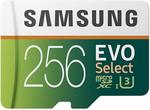Up to 100MB/s read and 90MB/s write speeds; UHS Speed Class U3 and Speed Class 10 (performance may vary based on host device, interface, usage conditions, and other factors)
Ideal for 4K UHD video recording, high-res photos, gaming, and music; For smartphones (Galaxy S10, S10+, S10e, S9, S9+, Note9, S8, S8+, Note8, S7, S7 Edge, other Android devices, etc.) and tablets, gaming consoles, laptops, action cameras, DSLR’s, drones, and more
Water-proof, Shock-proof, Temperature-proof, X-ray-proof, Magnetic-proof
Includes full-size adapter for use in cameras, laptops, and desktop computers
10-year limited warranty
Samsung MicroSDXC EVO Select Memory Card w/ Adapter 256GB $58.56 + Delivery (Free with Prime) @ Amazon US via Amazon AU
Last edited 22/07/2019 - 21:17 by 1 other user
 CamelCamelCamel.
CamelCamelCamel.Related Stores
closed Comments

FYI these are the same as EVO Plus

Friends, ignore my comment. I've deleted what I wrote.

Especially if you're red/green colourblind!

According to testing in the past, no. There is a youtube video where a guy finds they are different, and then for some reason says they are the same.

Broke mine newly open :(

Good thing there's a 10 year warranty!

Yeah, we'll call you.

When it's OOS :))

can i have your number so i can add you to my cold calling list?

Just so we're clear: this is a single card, not a pack of 20.

Does it work with Switch?

The Samsung EVO Select is on the list.
https://www.imore.com/best-microsd-cards-your-nintendo-switc…
There are three aspects of a microSD card you want to look at when buying one for Nintendo Switch storage:
Bus Speed - (Maximum speed the card can talk to the device):
The switch will work with any microSD card that uses bus speed UHS-1. You can tell that this microSD card is bus speed UHS-1 by noting the 'I' numeral on the face of the card.Minimum Sequential Write Speed (Minimum speed you can write data to the card):
Utilizing the bus speed of UHS-1, the fastest minimum sequential write speed available is U3 which guarantees 30MB/sec. You can tell that this microSD card has U3 minimum sequential write speed by noting the '3' inside the 'U' symbol on the face of the card.Application Performance Class (Minimum speed you can access data on the card):
The fastest minimum random read available is A2 which is 4,000 IOPS. You can tell that this microSD card is not rated in application performance class as there is no 'A2' depicted on the face of the card.
Note: If anyone is able to confirm A2 minimum speeds are present on this card please post a reply. Not sure why Samsung have not got the classification on their EVO Plus/Select microSD range.

So is it any good for the switch?

I would say from the few reviews I have seen on microSD cards that this is currently my second best choice, first being a Sandisk Extreme 512GB which has A2 classification and higher random read speeds.
Buy this and you will be happy.

So based on this report, A2 is basically marketing BS, get this card as it is faster at the A2 test than the A2 certified card:
https://www.jeffgeerling.com/blog/2019/a2-class-microsd-card…
Sandisk Extreme is faster than the Samsung Evo Plus/Select if your wanting the absolute best UHS-1 microSD you can get for the Nintendo Switch. Waiting for the price to come down on the 512GB model before I pull the trigger.
Interesting about the A2 classification, looks like they have not released updates that allow OS to utilize the technology.

@hey aj: OR they are are fudging the results as it looks like they are not testing to standard.
It won't be the first time, alas let's make 1000bytes as 1kb of storage while everything uses 1024 bytes as 1kb. Lol now our 475gb storage magically becomes 512gb!! This has been happening for far too long, so I won't be surprised if they did the same with A2.Besides those tests clearly shows that extreme and Evo plus are on par (if Evo not better). Don't get me wrong I was a bit believer in A2 as well, but my 64gb Evo plus is faster than my 128gb SanDisk extreme

@OpayuOnam: Not according to this article which was cited by the author of the article you posted:
https://github.com/ThomasKaiser/Knowledge/blob/master/articl…Right now A1 class microSD cards are performing better than A2 cards but when driver support becomes available we will be able to see if manufacturers are delivering the A2 speeds promised or if it's deceptive marketing… hopefully the former.
If you are buying a microSD card right now though I still recommend the Samsung Evo Plus/Select range as I have already recommended above, it's a fantastic card and will be one of the best options for Nintendo Switch storage. It's not my top choice but its a very close second, I am an optimist and hope that future-proofing with a microSD card that has A2 classification will reap benefits later down the track. That is why my personal top choice right now is the Sandisk Extreme 512GB (when the price drops to ~$100) but could change if Samsung do a refresh with A2 classification.

@hey aj: But that relies on Nintendo updating their firmware to support the functionality, that is a massive if.
But back to the point, the extreme has other benefits than write speed (more write cycles IRC) but purely from all around I think the Evo plus still wins as the price to performance ratio is better. If price is not an issue, then get the SanDisk pro which basically tips everything but comes at a massive extra cost.

Cheapest yet. Thanks OP bought one now.

But the better EVO plus locally have been cheaper and are regularly available for this price.

Temperature-proof
I challenge this statement.

And you'd be wrong. Put this card in temperature and you'll have your irrefutable proof of that extreme heat/cold. :)

Any Micro SD in a smaller capacity like 64GB or 128GB

no good warranty is only 10 years

In 10 years you'll likely be on petabytes. This thing would be looked at with the same disdain as a 2GB card right now. You'd just buy a new one if it failed.. if you were still using it, which I highly doubt.

yeah i know was just kidding 10 years is crazy long warranty

Stupid Question, can i use this for casual DSLR photography with the adapter. I wont be shooting 4K videos. Thanks.

99% yes

not necessarily, depending on what dslr you use some of the older ones have memory restrictions. I've got a d50 that wont take more than 2 or 4 gb

These are actually fast enough for 4K video
The adapter is just a pass through for wire contacts so shouldn't impact the speed in theory

Thanks OP

can i use this 256GB with Blackvue dashcam 750S?

Does anyone know what happens if you insert a higher-capacity memory card in a device, than what it's supposed to support?
For example, if I have a device whose specs state it takes 256GB, but I insert a 512GB or 1TB memory card, will it only recognise part of the capacity - or will it just not recognise the card at all?
The reason I'm asking is I bought a smartphone a few years ago (HTC One M9). Just before it was released HTC stated it would take a 1TB memory card. Many product reviewers whined about it, saying a 1TB card didn't even exist yet, no-one would need that much capacity (where have I heard THAT before), would cost more than the phone, etc.
Anyway, I bought the phone for that very reason… I wanted that capacity, figuring 1TB memory cards would eventually became available and become cheaper. But when HTC released the phone, the specs now stated the capacity was "up to 256GB".
I suspect the phone DOES actually take 512GB and 1TB cards. That they merely edited the quoted specs to say 256GB, because of the many whining reviewers, and because people would become confused, thinking it would take a memory card capacity of only 1GB instead of 1TB.
So I'd like to try inserting a card greater than 256GB and find out… But at the same I don't want to get stuck with a 512GB/1TB card the phone won't recognise. (Asking HTC gave no sensible answer. Their reps just quoted the listed specs, and didn't know for certain if HTC just edited the specs for marketing reasons, or if the memory capacity of the phone itself was actually reduced from 1TB to 256GB.)
So yeah… Does anyone know what happens if you insert a 512GB or 1TB card into a device that only takes 256GB?

Device may end up with stretch marks.

Nah, I don't want to impregnate it.

Does anyone know what happens if you insert a 512GB or 1TB card into a device that only takes 256GB?
It will self destruct mission impossible style. It will tell you it will self destruct and start a countdown.
/s

I have put 256GB micro SD into my gopro which stated it supported up to 128GB. I think manufacturers advertise qualified capacity rather than max capacity, because they have not tested and qualified it for their devices.

The interface for the cards is only different for <4GB (regular SD) and >=4GB (SDHC) so there's no hardware limitation that would apply for 128GB, 256GB, 512GB, etc.
If a device says "up to" a specific limit it's probably because they only tested it with cards up to that size, obviously they couldn't test with cards that didn't exist at the time the device was made.
In case of phones, as the underlying file system on SD Cards is (most of the times) exFAT, it should work. This is due to the fact that exFAT supports volume size up to 128 PB!!! https://en.wikipedia.org/wiki/ExFAT
So, as long as SD card is phisically compatible with a device, device supports the storage protocol (in this case UHS-I) and exFAT file system, capacity should not be a limitation (I made this statement as generic as possbile).

Even if the phones don't support exfat, they can reformat to fat32.

Interesting, thanks.

Support is a software thing. In the past because a certain size was the largest available when a device was produced it was quoted, and later larger sizes did often work. You would be best to look for forum posts and comments from owners of your hardware to determine.

I did look at the time (just after purchasing it). But I guess I should search again, thanks.

The limitation in Android is actually 2TB if I remember correctly.
I have used a 200gb card in a Galaxy S4 without issues

Hm… So it was supposed to be up to 64GB it appears. Interesting, thanks.

2TB is the limit as long as sectors are 512 bytes. Then we either need bigger sectors or a new SD command set, since all the commands use 32-bit values for sectors.

Can't wait until the 512GB are this price!

This is fine to use with a dashcam like the viofo a129?

very good value. I ordered 128gb at $40 aud in ebay, I cancelled order and bought this.
At least $30 bargain!

Noob Q. Would this work with the Go Pro Hero?

Yes. But you are always best to do your own research on other users experience with devices and memory cards at different bit rates. It depends on what format you are recording in that determines the speed required. eg The GH5 records at 400mbs at its highest 10bit setting which means special cards are required. But not many shoot in that high a quality so cards such as this suffice at other bit rates.

Thanks mate. I actually researched and found that thr Go Pro Hero (2018) does not support this card.

Would this work in Nvidia Shield?





bargain!